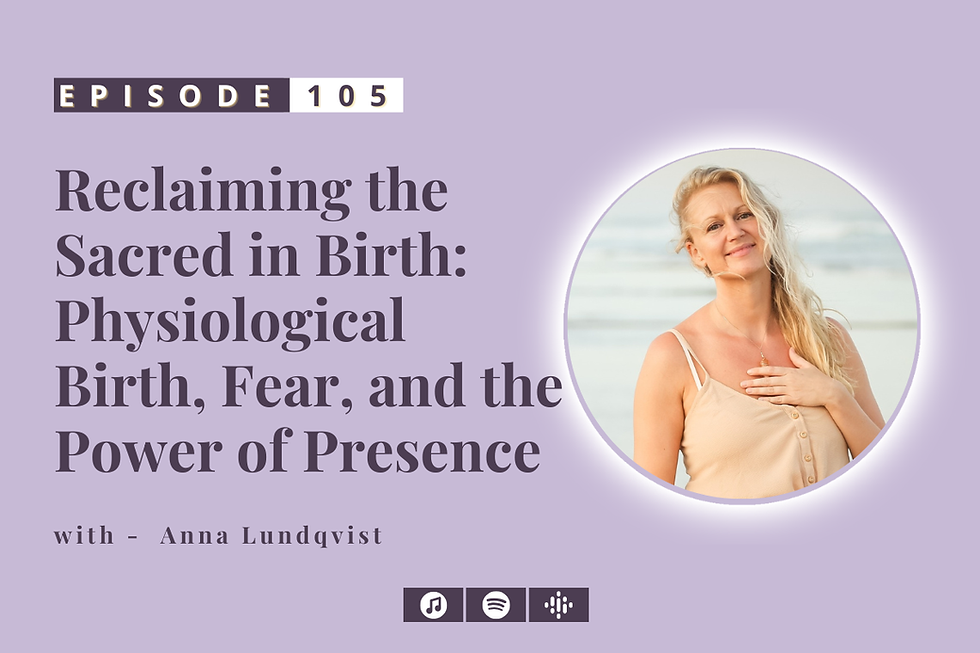#17: Reconnecting to the Power of Our Wombs
- Clara clarajorourke@gmail.com
- Dec 5, 2023
- 4 min read

In this episode, we delve into the sacred and often overlooked center of our being – the womb. Irrespective of our differences, our lives share a common origin in the womb.
Millennia ago, people revered the womb as a sacred place, the source of life, creation, and infinite possibilities. However, for many, the connection to this powerful center has been severed, leaving it wounded and forgotten.
In this episode, we dive into the following:
Explore the profound connection between our womb, yoni, and the first and second chakras – the root and sacral chakras.
Discover the significance of the root chakra, situated at the base of the spine, providing stability and grounding.
Uncover the interconnectedness of foundational chakras with higher chakras, especially the throat and heart.
Understand that every human has a connection to these chakras.
Delve into the concept of the womb as the seat of Kundali Shakti, the serpent power in Sanskrit.
Discover simple yet powerful techniques to connect with your womb, including breathwork.
Listen to the podcast now:
Welcome back to another episode of the Mindful Womb Podcast. Welcome to a transformative space where we dive into the sacred depths of our being - the womb. Regardless of our backgrounds or experiences, one universal truth unites us all: our origin from this mystical vessel of life. For eons, cultures revered the womb as a divine source, acknowledging its role in creation and the boundless possibilities it embodies. Yet, in our modern lives, many have lost touch with this profound part of ourselves.
The womb, a spiritual epicenter within us, holds immense power, often overlooked or forgotten amidst life's hustle and bustle. We tend to notice its presence during pivotal moments: menstruation, conception, pregnancy, and menopause. However, the womb space holds far more significance than these milestones suggest. When we tap into its power, our lives undergo a profound transformation.
Just as the cosmos extend boundlessly beyond us, the universe resides within us, particularly within the womb and yoni (the Sanskrit term for womb and vagina). These areas are intimately linked to the foundational root and sacral chakras, energetic centers governing our sense of stability, creativity, and vital instincts.
Perhaps you're new to the concept of chakras. Picture them as energy hubs aligning with nerve clusters and internal organs, forming a bridge between our physical and emotional states. Originating from ancient Indian scriptures called the Vedas, these chakras possess an age-old legacy, influencing various Eastern medicinal practices.
Let's dive into the first two chakras:
The Root Chakra: Symbolized by an earthy red hue, it resides at the spine's base, fostering a sense of connection to our physicality and vitality. This chakra grounds us, providing stability and support while nurturing our survival instincts, including food, reproduction, sleep, and self-preservation.
The Sacral Chakra: Positioned just above the root, it emanates a deep amber glow, representing our capacity for creation. This powerful center aligns with our feminine aspects, creativity, and the ability to birth new life—whether artistic endeavors or physical offspring.
During pregnancy, heightened sensations often stem from these chakras' bustling activities. Our senses are heightened, attuning us to the energetic changes within the womb.
Balancing these foundational chakras paves the way for harmony and interconnectedness within our entire being. It's akin to tuning in to our truest essence, expressing emotions, intuition, and sensuality while feeling secure and connected.
In labor, as I guide my clients, we emphasize the importance of low moans and relaxed jaws. The vagus nerve, stretching from the throat to the pelvis, links these areas, both energetically and physically. Relaxing these zones proves beneficial, enhancing our ability to communicate our needs and aligning our actions with our genuine desires.
Regardless of gender or physical presence of a uterus, we all harbor a connection to these chakras. The uterus, a space where life is conceived, embodies profound significance beyond its reproductive function. It's a sanctuary where creativity thrives, sexuality finds honor, and unaddressed traumas might reside.
Sometimes, the physical changes during pregnancy can stir up these unresolved conflicts or traumas stored within. Acknowledging these emotions and seeking support to navigate through them is crucial.
Healing the womb space is a journey toward reclaiming power and self-worth. It's a pathway to nurturing creativity, gaining confidence in our bodies, and trusting our choices, reducing the need for external validation.
One of the simplest ways to connect with our womb is through breath. By setting intentions and practicing mindful breathing, we can clear negative emotions and infuse the space with love and compassion. This practice, when integrated into daily routines, fosters healing and self-empowerment.
Remember, dear ones, your intuitive wisdom and creative centers are potent forces waiting to be awakened. By tuning into these spaces within, you unlock a reservoir of strength and alignment, enabling you to manifest a life in harmony with your truest self.
So, take those moments, breathe into your womb's luminous light, and embrace the transformative power within you. As you embark on this journey, may it be filled with self-discovery, healing, and profound connection.
Honor your sacred space and cherish the incredible being you are.
Thank You for Listening
If this episode lights you up, I’d love it if you’d rate and review the show on Apple Podcasts, Spotify, or wherever you listen to podcasts. After you review the show, snap a pic and upload it here… and I’ll send you a little surprise as a thank you.
Your feedback helps this podcast grow, and I am so grateful for your support!
Don’t forget to subscribe to the Mindful Womb Podcast on iTunes so you never miss an episode.




Comments